June 28th, 2018
in Analysis, Legislative Operations
In my last post, I argued that the process of drafting new legislation should be undertaken with a problem-solving mindset. I suggested that problem-solving tools from a variety of disciplines could be advantageously adapted to the legislative process. In this post, I will present the manner in which one specific tool—Failure Modes and Effects Analysis (FMEA)—could be used in legislative drafting.
FMEA was originally developed as a tool to improve processes within the manufacturing industry. An FMEA is a “systemic method of identifying product and process problems before they occur.” Robin E. McDermott, Raymond J. Mikulak, Michael R. Beauregard, The Basics of FMEA 3 (1996). (Many of the details of the FMEA process discussed in this post come from The Basics of FMEA. I highly recommend that anyone interested in performing FMEAs in the legislative process read this book. The steps of an FMEA can be found in the book or online, here.) In the manufacturing context, the goal of an FMEA is to figure out how a new product or process is likely to fail, before that failure happens, and then to recommend improvements that will preemptively prevent the failure. In FMEA terminology, the process is designed to identify and resolve “failure modes” in a product or process.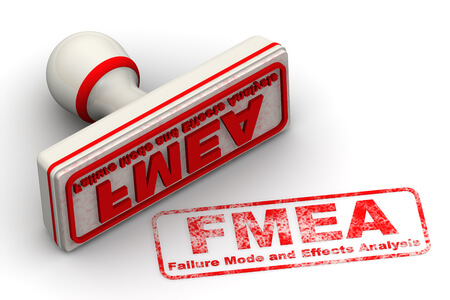
In the legislative context, a bill working its way through the legislature can be thought of as the new “product or process” to which an FMEA can be applied. In this post, I will discuss where in the legislative process an FMEA could be performed, what the make-up of an FMEA team might be, and what beneficial output could be expected from an FMEA.
The authors of The Basics of FMEA, recommend that “[i]deally, FMEAs are conducted in the product design or process development stages, although conducting an FMEA on existing products and processes may also yield huge benefits.” The Basics of FMEA at 3. Likewise, a legislature could use FMEAs to analyze already existing laws. However, in this post, I will only describe FMEAs that would take place during the drafting process. Such an FMEA would likely be most useful to the legislative process after a committee performs hearings and before it votes on a bill. At this point, the committee has already gathered a wealth of useful information and the legislature still has wide latitude to make changes to the bill when potential failure modes are discovered.
The FMEA team itself should consist of four to six members. Id. at 15. Idealistically, the team will “bring a variety of perspectives and experiences to the project.” Id. This will likely result in team members having varying degrees of expertise in the relevant subject matter and a range of familiarity with the legislation being reviewed. For example, an FMEA team for a bill related to criminal justice might include: a legislative attorney familiar with the bill, a representative from the police force, an associate district attorney, a public defender, and representatives from advocacy groups or lobbyists. It is worth noting that many of the individuals on the team may be the same individuals who provided testimony in a committee hearing. Such overlap does not diminish the unique value that can be obtained by an FMEA. Likewise, an FMEA would in no way detract from the value of the committee hearing. Committee hearings give advocates an opportunity to state their case and respond to questions from members of the committee. The FMEA would give these individuals an opportunity to interact with one another and to work towards improving legislation in ways in which they can all agree.
It is also important to note that many of the FMEA team members may also represent the individuals that the law is meant to address—the “role occupants” and implementing agencies. See Ann Seidman & Robert B. Seidman, Instrumentalism 2.0: Legislative Drafting for Democratic Social Change, 5 Legisprudence 95, 95 (2011). The Seidmans note that a role occupant’s failure “to respond to a law’s commands, prohibitions or permissions, signifies . . .
that, in drafting the bill’s detailed prescriptions, the drafter failed adequately to take into account the relevant constraints and resources in the role occupant’s environment.” Id. at 136. Bringing representatives of role occupants and implementing agencies into the legislative process via FMEAs would help to reduce these drafting failures.
Of course, the ultimate language of a bill must be determined by legislators and legislative attorneys. Nevertheless, the recommendations of an FMEA team regarding specific bill language could be of significant help to those tasked with the actual drafting of the bill. An appropriate balance of power between drafters and the FMEA team can be established by providing FMEA teams with “clearly defined boundaries within which they are free to conduct the FMEA and suggest and implement solutions.” The Basics of FMEA at 20-23. For example, the scope of a drafting-focused FMEA could be limited to the language of the bill, excluding considerations of the substantive legislative plan embodied in the bill. While a broad legislative scheme may be well suited to effectuate desired change, the language of a bill may fail to adequately implement the legislative plan. Such an FMEA could identify, document, and recommend corrections to any problematic drafting discovered. Once the bill is revised, the FMEA team could re-convene and repeat its analysis.
Whenever a new step is added to a process, a fear may arise that the process is becoming more complex, and therefore less efficient. The inclusion of FMEAs in the process of drafting legislation would undoubtedly require legislative drafters to overcome a steep learning curve. Once that learning curve is overcome, however, use of the FMEA methodology will yield significant benefits. In the short term, the FMEA could uncover and correct potential problems in a bill before it leaves its committee. In the long term, effective FMEAs would decrease the likelihood that laws would need to be revised to address problems that were not foreseen during the drafting process. Idealistically, the end result will be a more efficient legislative drafting process resulting in the passing of better drafted laws.
 Andrew P. McDonough graduated from Boston University School of Law in May 2018.
Andrew P. McDonough graduated from Boston University School of Law in May 2018.
Tagged Boston University Law School, BU Law, evidence-based legislation, Failure Modes and Effects Analysis, FMEA, ILTAM, Professor Ann Seidman, Professor Robert Seidman
June 28th, 2018
in Analysis, State Legislation
In April 2017, the Florida legislature passed a resolution (HCR 631) formally apologizing for the unjust prosecution and persecution of the “Groveland Four”, and calling for their exoneration by Governor Rick Scott. The “Groveland Four” is the popularized moniker for Charles Greenlee, Walter Irvin, Samuel Shepherd, and Ernest Thomas; four young black males (age 16 and up) accused of raping a 17-year-old white woman in Groveland, 1948. The infamous case took place during the Jim Crow era, following generations of wrongfully accused, wrongfully prosecuted, wrongfully convicted, and wrongfully executed black citizens. Shortly after they were accused of the crime, Samuel Shepard and Walter Irvin, both World War II veterans, were abducted by law enforcement officers and taken to a secluded spot to be beaten and tortured. After this assault, the deputy officer took Shepard and Irvin to the scene of the crime, only to find that their shoes did not match the footprints that allegedly belonged to the true assailants. Frustrated, the officers took Shepard and Irvin to an interrogation room where they were beaten and tortured until they confessed.
Eventually, Charles Greenlee was picked up by the authorities and subjected to the same treatment a
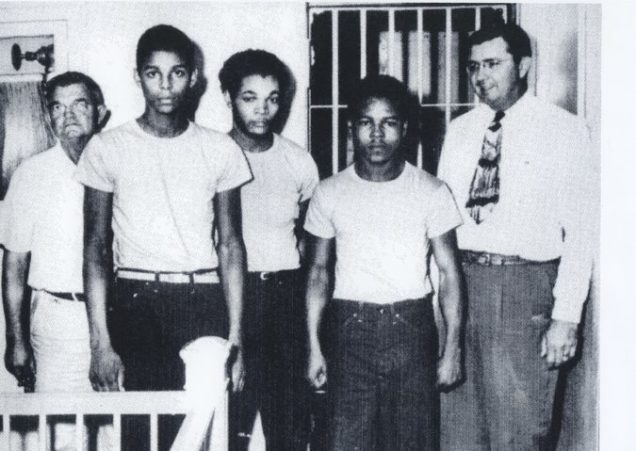
Charles Greenlee, Samuel Shepherd and Walter Irvin in custody
Shepard and Irvin, but Ernest Thomas caught wind of the investigation and attempted to flee. Thomas’s flight incited a lynch mob, led by both the local sheriff’s department as well as the Ku Klux Klan. The mob not only hunted down and killed Thomas over 200 miles away, but also terrorized the black, segregated section of Groveland, burning down the suspects’ houses and causing numerous black residents to abandon the city in fear. Sheriff Willis McCall, though complicit in stirring up some of chaos, attempted restoring a semblance of order by having the remaining suspects moved from the local jail to the state prison to await trial. The NAACP and the FBI got involved with the case as national attention grew. After documenting the beatings and torture by local law enforcement, the FBI recommended that the Tampa U.S. Attorney General bring charges, but no indictments were made. Franklin Williams of the NAACP represented the remaining suspects, and through his own investigation, suspected the rape accusation was actually a cover-up of a domestic violence incident between the accuser and her boyfriend. During the trial, there was evidence that the suspects had not been in town during the incident and that the footprint (which never matched the suspects’ shoes) was fabricated by the deputy. Still, an all-white jury found Shepard, Irvin, and Greenlee guilty within minutes of deliberating, sentencing Shepard and Irvin to death, and 16-year-old Greenlee to life in prison.
 The United States Supreme Court overturned the capital convictions (Greenlee never appealed) and remanded the case for retrial. Sheriff McCall was transferring Shepard and Irvin back to Lake County (Groveland’s county) for the trial, when McCall claimed he was attacked by the two black men and forced to shoot them in self-defense. Fortunately, Irvin survived the multiple gunshots and told his version of events, which included an unprovoked execution of Shepard and collusion between McCall and his deputy to cover up the failed execution of Irvin. At the retrial, eventual first black Supreme Court justice, Thurgood Marshall represented Irvin, but faced problems similar to the first trial, and Irvin was sentenced to death again. The Florida governor spared Irvin and commuted his sentence to life in prison; Irvin went on to spend 14 years in prison and was released in 1968. He fled Florida for Tennessee, but came to visit Lake County in 1970, where he was found dead in his car. Greenlee was eventually released.
The United States Supreme Court overturned the capital convictions (Greenlee never appealed) and remanded the case for retrial. Sheriff McCall was transferring Shepard and Irvin back to Lake County (Groveland’s county) for the trial, when McCall claimed he was attacked by the two black men and forced to shoot them in self-defense. Fortunately, Irvin survived the multiple gunshots and told his version of events, which included an unprovoked execution of Shepard and collusion between McCall and his deputy to cover up the failed execution of Irvin. At the retrial, eventual first black Supreme Court justice, Thurgood Marshall represented Irvin, but faced problems similar to the first trial, and Irvin was sentenced to death again. The Florida governor spared Irvin and commuted his sentence to life in prison; Irvin went on to spend 14 years in prison and was released in 1968. He fled Florida for Tennessee, but came to visit Lake County in 1970, where he was found dead in his car. Greenlee was eventually released.
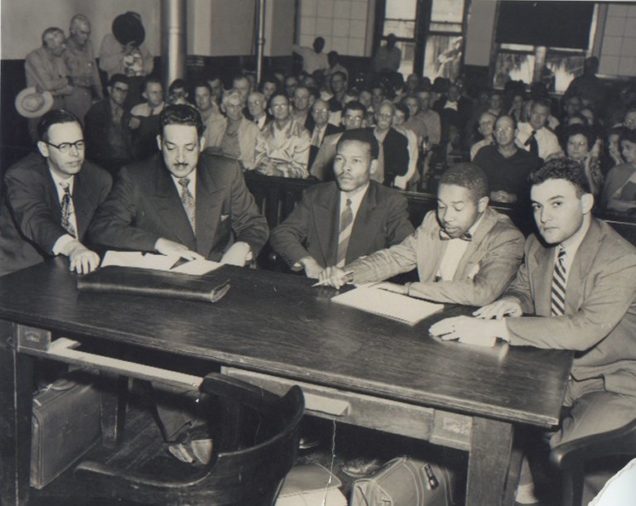
Irvin with his lawyers Alex Akerman, Thurgood Marshall, Paul Perkins and Jack Greenberg
The terrible saga of the Groveland Four is only a snippet of the corruption and racism that plagued Lake County, Florida, and the criminal justice system as a whole during and after Jim Crow. Still, this recent formal apology only follows after mounting public pressure to acknowledges the horrendous wrongs of the state. In 2012, the same year Greenlee died, the book Devil in the Grove, which tells the story of the Groveland Four, came out. This book not only renewed interest in the case, but also won a Pulitzer Prize. The book drove a University of Florida student to launch a massive Change.org petition, and with the help of the Miami Herald and Greenlee’s daughter, the matter of an apology and exoneration finally reached a boiling point. Now that an acknowledgment and formal apology has passed the legislature, the wronged accused’s families – and history itself – await the posthumous exoneration by the governor.
If the governor eventually exonerates these innocent African Americans, after waiting over a year to do so, it would follow a growing trend of acknowledging the terrible failures of the criminal justice system and political leaders during the 20th century. However, given the quantity and severity of these failures, should leaders be taking more active steps to right these egregious wrongs, instead of simply apologizing and exonerating? While surviving family members of these victims may be gladdened by a formal acknowledgement of the truth, should they be compensated for their generational pain and suffering, lost wages, even lost earning potential? The impact of these unjust persecutions is not limited to their historical time period, nor to the victims’ families – the community, and even the whole nation, felt the repercussions of these state sanctioned racist acts. These acts also highlight glaring failures of accountability and checks and balances in the criminal justice system. Politicians score political points for acknowledging their state’s past, without taking proactive measures to prevent the same injustices in the future. Civil rights activists believe lawmakers should do more than just apologize, and instead commit resources to ensuring citizens are educated about these dark corners of history, as well as reforming law enforcement offices to ensure accountability and true justice. Others believe that the apologies are not even necessary; what happened in the past should remain there, and present-day America should not apologize for the sins of its fathers. Either way, as the nation reconciles more of these injustices, lawmakers should be thinking of ways to protect their constituents from future injustice.
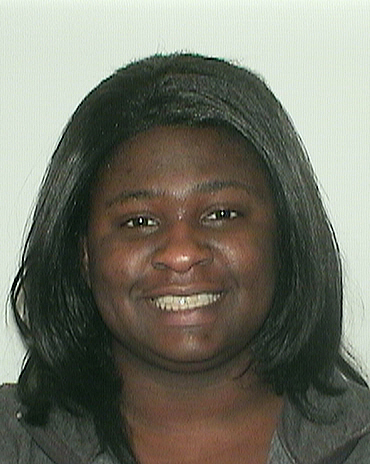 Andrea Ogechi-Okoro graduated from Boston University School of Law in May 2018.
Andrea Ogechi-Okoro graduated from Boston University School of Law in May 2018.
Tagged Boston University Law School, BU Law, civil rights, Florida, Gov. Rick Scott, Groveland Four, wrongful conviction
June 28th, 2018
in Analysis, Federal Legislation
On December 20, 2017 Congress passed H.R. 1, the Tax Cuts and Jobs Act. This act introduces the most sweeping tax changes in decades lowering individual and corporate tax rates, with one stated goal of allowing buyers to write off the costs of new investments. In relevant part, this Act introduces one provision that removes a favorable tax rate for innovators with self-created intellectual property and eliminates the ability to treat certain self-created intellectual property as capital assets.
Under the prior tax scheme, self-created intellectual property would have been subject to the capital gains tax rate following sale of those assets. However, Section 1221 of the Internal Revenue Code under the new law exempts self-created intellectual property from capital gains treatment.
 “This new tax law amends IRC Section 1221(a)(3), resulting in the exclusion of a patent, invention, model or design (whether or not patented), and a secret formula or process that is held either by the taxpayer who created the property or a taxpayer with a substituted or transferred basis from the taxpayer who created the property (or for whom the property was created) from the definition of ‘capital asset.’ As a result of this exclusion, gains or losses from the sale or exchange of a patent, invention, model or design (whether or not patented), or a secret formula or process that is held either by the taxpayer who created the property or a taxpayer with a substituted or transferred basis from the taxpayer who created the property (or for whom the property was created) will not receive capital gains treatment.”
“This new tax law amends IRC Section 1221(a)(3), resulting in the exclusion of a patent, invention, model or design (whether or not patented), and a secret formula or process that is held either by the taxpayer who created the property or a taxpayer with a substituted or transferred basis from the taxpayer who created the property (or for whom the property was created) from the definition of ‘capital asset.’ As a result of this exclusion, gains or losses from the sale or exchange of a patent, invention, model or design (whether or not patented), or a secret formula or process that is held either by the taxpayer who created the property or a taxpayer with a substituted or transferred basis from the taxpayer who created the property (or for whom the property was created) will not receive capital gains treatment.”
Effectively, the sale of self-made intellectual property typically will now be subject to the higher top individual tax rate of 37 percent, as opposed to the capital gains tax rate of 20 percent. In practice, this will dramatically alter if and how a seller chooses to dispose of these assets.
Before, sellers would be encouraged to sell self-made intellectual property; however, under the new scheme, sellers are less encouraged to sell these assets because they will be subjected to a significantly higher tax rate. Under the previous tax scheme, a partnership’s sale of assets could be eligible for the long-term capital gains rate. Under the new Act, entrepreneurs and individual inventors possessing newly designed, self-made technologies will not be eligible for the lower capital gains rate when they create a company from that technology or sell the technology to another who will create a company. To net the same amount of after-tax dollars following a sale, owners of self-created intellectual property must seek a higher purchase price to offset the higher tax treatment. In effect, the new tax scheme alters the pricing and value of a patent.
Congress’s intent regarding the capital gains tax is that profits and losses arising from everyday business operations be characterized as ordinary income and loss, not capital gains. Therefore, the “self-made intangibles” exclusion is likely to be broadly construed to include most forms of intellectual property and this exclusion furthers that broad purpose. However, the practical effect of this exclusion from the capital gains tax is curious considering Congress’s goals of the Tax Cuts and Jobs Act. The exclusion eliminates an incentive to sell assets, which conflicts with the legislation’s goal of allowing buyers to write off the cost of new investments. Rather than further incentivizing investment, this provision erects a significant barrier to investment. Buyers will be eager as ever to purchase assets because of immediate expensing, but sellers will be hesitant to sell.
operations be characterized as ordinary income and loss, not capital gains. Therefore, the “self-made intangibles” exclusion is likely to be broadly construed to include most forms of intellectual property and this exclusion furthers that broad purpose. However, the practical effect of this exclusion from the capital gains tax is curious considering Congress’s goals of the Tax Cuts and Jobs Act. The exclusion eliminates an incentive to sell assets, which conflicts with the legislation’s goal of allowing buyers to write off the cost of new investments. Rather than further incentivizing investment, this provision erects a significant barrier to investment. Buyers will be eager as ever to purchase assets because of immediate expensing, but sellers will be hesitant to sell.
There are a few limitations to this discussion. Section 1221’s exception of intellectual property from the capital gains tax rate will likely only have a practical effect on the behavior of individuals, rather than corporations. The difference between the capital gains rate and ordinary income is much greater for individuals than it is for corporations; the corporate tax rate under H.R. 1 is 21 percent, only a one percent increase from the capital gains rate, as opposed to a 17 percent increase between the capital gains rate and the top individual income rate. Therefore, corporations are unlikely to treat the sale of these “self-created tangibles” significantly differently than under the previous tax scheme, at most seeking a modest increase in sale price to accommodate the one percent tax increase. In addition, Section 1221(b)(3) directs that musical compositions and copyrights in musical works may still be treated as capital assets. Therefore, not all intellectual property will be affected by this categorical exclusion from capital gains.
 Eric Dunbar graduated from Boston University School of Law in May 2018.
Eric Dunbar graduated from Boston University School of Law in May 2018.
Tagged Boston University Law School, BU Law, capital gains, intellectual prpoerty, IP, IRS, Tax Cuts and Jobs Act, taxation, taxes
June 28th, 2018
in Analysis, State Legislation
Supreme Court justice Louis Brandeis once called America’s states “laboratories of democracy;” state legislatures can tinker with public policy and, in theory, see what works and doesn’t work. One area where these laboratories are in full swing is in the area of state-level veteran’s benefits.
Many states provide basic benefits, in addition to benefits provided at the federal level, for veterans who serve the nation honorably and meet eligibility criteria. Things like: free admission to parks, hunting and fishing licenses at low or no cost, reduced rates for education at state funded colleges and universities, tax reductions and rebates, and veteran’s preferences for hiring in state jobs, are relatively common. Some states experiment with veteran’s policy by pushing well beyond these common state programs. Texas for example, through the very generous Hazelwood Act, provides up to 150 hours of exemption from tuition for veterans at state colleges and universities, or, if the veteran doesn’t use the benefit, for their spouse or child. Quite a few states (including Massachusetts) fund veteran’s nursing homes and are working to tackle veteran’s homelessness.
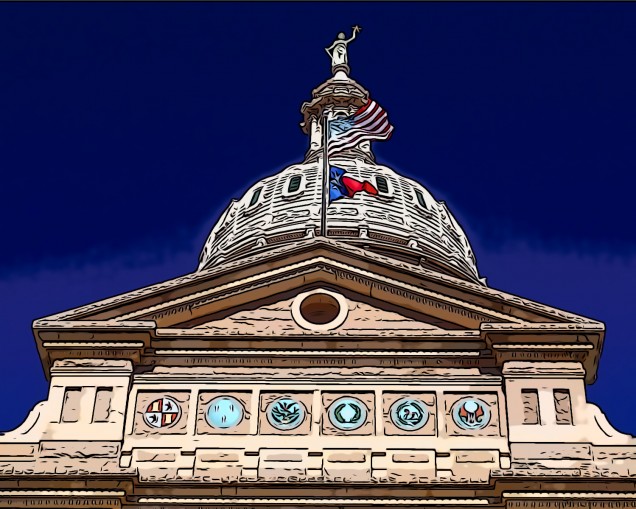
Texas State Capitol
Austin 1888
All of these programs are impressive and necessary and, they couldn’t be more important. Current veteran suicide rates are staggeringly high. More than seven thousand veterans took their lives in 2014. Of those veterans 70% were not enrolled in the federal VA system. That crisis, coupled with high veteran homelessness rates, poses significant risks to veterans living on the border of, or in, poverty. States address these challenges among their veteran populations in a variety of ways, but it is the way that Massachusetts offers commonwealth veterans in need assistance that show its progressive roots. Roots that stretch back to the Civil War.
During the Civil War, Massachusetts passed Mass. General Law Chapter 115 (Chapter 115). The statute has grown since then, but it has always provided a veteran’s agent in every Commonwealth municipality and assistance with veteran burials and grave services. Today, Chapter 115 benefits still provide a veteran’s agent (now referred to as a veterans service officer or VSO) and cemetery services, but the statute also provides a comprehensive benefit that truly seeks to serve those who have served.
This benefit is probably one of the most effective income-assistance benefits in the nation. It is funded through a city/state partnership where the city’s employee, the Veteran Service Officer (certified and trained by the state Department of Veteran’s Services), uses the regulations promulgated by the state Department of Veteran’s Services (108 Code of Massachusetts Regulation) to makes a determination about the eligibility of the veteran. Initially, if a veteran is eligible for Chapter 115, the veteran’s benefit is paid from the city’s budget. This process makes the Veteran Service Officer accountable to their respective Mayors, City Mangers, and City Councils.

The Massachusetts State House
Boston, 1787
In addition to being accountable to the municipal leadership, when a VSO approves Chapter 115 benefits auditors at the state Department of Veteran Services also reviews the veteran’s file to ensure that eligibility criteria are met and statutory guidelines and obligations are followed. If a VSO denies chapter 115 benefits, or removes a veteran from the program for failure to comply with job searches or income reporting mandates, the veteran can appeal that decision to the state Department of Veteran’s Services (and to higher administrative courts if necessary).
Throughout the veteran’s participation in the Chapter 115 program the Veteran Service Officer has statutory obligations to help the veteran file any and all VA claims and applications for healthcare and other social safety net benefits and to ensure that veterans that are able to work are actively seeking employment and reporting their income to the VSO. Commonwealth VSOs become, throughout this process, the veteran’s advocate, mentor, and coach. Finally, at the end of the fiscal year, 75% of the Chapter 115 benefits that the city pays out are reimbursed by the state Department of Veteran’s Services.
Are Chapter 115 benefits a perfect solution to all the challenges that commonwealth veterans face? Of course not. No government program, non-profit, charity, or business can address all of the complex issues that American veterans deal with. The challenges in transitioning from service in our all-volunteer military to civilian life are serious, but they are surmountable. Examples like the Hazelwood Act and Chapter 115 benefits are just two examples of how to create a net of support for veterans. Other states should look to Texas and Massachusetts to create similar programs, while continuing to experiment.
 Kenneth Meador was an Army combat medic who graduated from the University of Oklahoma and Boston University School of Law (2018). He plans to focus his legal career on helping our nation's veterans.
Kenneth Meador was an Army combat medic who graduated from the University of Oklahoma and Boston University School of Law (2018). He plans to focus his legal career on helping our nation's veterans.
Tagged Boston University Law School, BU Law, Chapter 115, Hazelwood Act, Massachusetts, Texas, VA, Veterans Administration, Veterans benefits
June 18th, 2018
in Conference, News
April 25, 2018 at 5:57 am
For those of you loyal readers of the BU Law Blog, you may have seen Brynn’s earlier post about the International Conference on Legislation and Law Reform in Washington, DC. I also had the chance to head down to our nation’s capital last week and participate in the conference, which was co-sponsored by BU Law.
When Professor Kealy first sent out the email letting us know about the conference, I jumped at the opportunity to spend a few days in DC and hear from some of the experts who write the words that become law around the world. The agenda was packed with an interesting and diverse set of speakers who covered a wide range of topics relating to the creation and refinement of legislation.
I took the overnight Amtrak from Boston and arrived in DC to a spectacular spring morning. On the drive from Union Station to the conference at American University, the cherry blossoms were in full bloom as if to welcome the conference attendees in a uniquely Washingtonian way. Right off the bat, Professor Voermans from Leiden University set the tone with an interesting presentation on the balance between legislative efficiency and transparency. Of note, he cited Professor Kealy’s study of American legislative drafters to illustrate the role technology has played in the field. I have to say, it was pretty exciting to see my clinical professor’s work globally recognized; it just goes to show what a terrific opportunity the legislative drafting clinic is.
There were other great presentations, including U.S. Congressional and Senate drafting veterans discussing their experience with the demands of legislators who want bills written in impossibly tight timelines. They provided a glimpse into the practical realities of Washington, and how we, as the public, often think that laws should just magically appear when we want them. There were presentations on the legislative approaches in the EU, Ethiopia, and China. Still others discussed some of the hot topics of the day, such as ways that legislation can address climate change and the needs of post-conflict states.
Overall, it was an extraordinary privilege to sit in on some of these discussions as a law student and gain an appreciation for the technical and professional complexities that come with the work of making law. For those of us who took the legislative drafting clinic, we had some exposure to the effort that goes into each bill, though we mostly worked on a single piece of legislation. It is quite another thing to deal with demand of dozens of different constituencies, so it was fascinating to meet the community of a scholars and drafters who do so on a daily basis.

…and I finally got to wear my lapel pin.
After the conference wrapped up for the day, I had dinner out in town and took a walk around the capital. I felt that I had a different appreciation for the city and its inner workings. Among the neo-classical buildings, windows were lit sporadically, behind which government employees were likely burning the midnight oil to do the work of the people. As serendipity would have it, earlier that same day, the bill I wrote in the legislative drafting clinic was reported favorably out of committee in the Massachusetts State House. I am grateful that law school has given me the tools to do my part—perhaps one day in the not-too-distant future, the bill I worked on will become part of the Massachusetts General Laws and I can count myself among those who have helped translate an idea into legislation.
By William Wilson | Posted in Clinics, Extracurriculars, In the Community
William Wilson | Posted in Clinics, Extracurriculars, In the Community
Tagged I'm Just a Bill, ilegis.org, International Conference on Legislation & Law Reform, Sean Kealy, Wim Voermans
June 18th, 2018
in Conference, News
April 22, 2018 at 5:46 pm

Last week I had the privilege of once again attending the International Conference on Legislation and Law Reform, held at the Washington College of Law at American University. I had attended last year’s conference along with several other alumni from BU’s Legislative Policy & Drafting Clinic; you can read that blog entry here. This time around I had the honor of participating in the conference as a panelist!
 Several old favorites returned as speakers, such as the inimitable Judy Schneider, although the conference also featured a number of new panels.
Several old favorites returned as speakers, such as the inimitable Judy Schneider, although the conference also featured a number of new panels.
Judy, a legislative expert at Congressional Research Service who co-authored the Congressional Deskbook, captivated the audience with her witty rendition of how Congress really works. Judy runs a boot camp for each new class of U.S. Representatives on congressional procedure. She shared with us the magic formula for passing bills that she gives to incoming members of Congress: You need the policy; you need the politics (though this is not to be confused with party politics); and you need the procedure. She went on to explain that most of us learned civics incorrectly—Congress was not created to pass laws, but rather “to prevent bad laws from being enacted”—then walked us through each chambers’ political and procedural hurdles in committee and on the floor.
I also really enjoyed a panel on Outside Drafters, which was new to the conference this year. The panelists were Rochelle Woodard, from the Department of Commerce, and Ronald Lampard, the Criminal Justice Task Force Director at the American Legislative Exchange Council. Both brought fascinating perspectives on drafting language for lawmakers, although neither worked within the legislative branch. Rochelle spoke of the challenges she faces as an agent of the executive branch whose job is to implement treaties and consult on export control, and discussed how she goes about balancing these responsibilities with drafting language for Congress that Legislative Counsel will inevitably review and revise. Ronald, by contrast, works for a national advocacy organization that drafts both model legislation and state-specific legislation for lawmakers. With respect to the latter, he emphasized the need for local buy-in and how he approaches collaborative drafting with stakeholders.
 I had the great honor of participating in the last panel of the conference, Teaching Legislative Drafting, with my clinic professor, Sean Kealy. Professor Lou Rulli, who runs the Legislative Clinic at Penn Law, was also on the panel with one of his former students. Both professors spoke of the importance of teaching legislative drafting to law students and discussed their respective curricula. I talked about the bill that I drafted when I was a member of BU’s Legislative Policy & Drafting Clinic. My client was a State Senator who asked me to draft a bill from scratch, aimed at mitigating collateral consequences to incarceration in Massachusetts. I had a great time sharing my experiences as a student in the clinic and how the skills that I learned have come in handy during my externship with the Senate HELP Committee.
I had the great honor of participating in the last panel of the conference, Teaching Legislative Drafting, with my clinic professor, Sean Kealy. Professor Lou Rulli, who runs the Legislative Clinic at Penn Law, was also on the panel with one of his former students. Both professors spoke of the importance of teaching legislative drafting to law students and discussed their respective curricula. I talked about the bill that I drafted when I was a member of BU’s Legislative Policy & Drafting Clinic. My client was a State Senator who asked me to draft a bill from scratch, aimed at mitigating collateral consequences to incarceration in Massachusetts. I had a great time sharing my experiences as a student in the clinic and how the skills that I learned have come in handy during my externship with the Senate HELP Committee.
While there were far too many fabulous panels to highlight here, I would be remiss if I failed to mention the international nature of the conference. Half of the panels were dedicated to legislative issues that drafters in other jurisdictions face. I heard from drafters from Ghana, Ethiopia, China, the EU, and members of the Commonwealth Association of Legislative Counsel. They spoke on topics ranging from telecom regulations in Uganda to public participation in the legislative process in Korea to promoting drafting uniformity in Australia.
If you are interested in gaining insight into the intersection of policy, drafting, and law reform, this annual conference is not to be missed! For information about future conferences, visit http://www.ilegis.org/.
Tagged Boston University Law School, Brynn Felix, BU Law, ilegis.org, International Conference on Legislation & Law Reform, Legislative Policy & Drafting Clinic, Louis Rulli, Sean Kealy
 Several old favorites returned as speakers, such as the inimitable Judy Schneider, although the conference also featured a number of new panels.
Several old favorites returned as speakers, such as the inimitable Judy Schneider, although the conference also featured a number of new panels. I had the great honor of participating in the last panel of the conference, Teaching Legislative Drafting, with my clinic professor, Sean Kealy. Professor Lou Rulli, who runs the Legislative Clinic at Penn Law, was also on the panel with one of his former students. Both professors spoke of the importance of teaching legislative drafting to law students and discussed their respective curricula. I talked about the bill that I drafted when I was a member of BU’s Legislative Policy & Drafting Clinic. My client was a State Senator who asked me to draft a bill from scratch, aimed at mitigating collateral consequences to incarceration in Massachusetts. I had a great time sharing my experiences as a student in the clinic and how the skills that I learned have come in handy during my externship with the Senate HELP Committee.
I had the great honor of participating in the last panel of the conference, Teaching Legislative Drafting, with my clinic professor, Sean Kealy. Professor Lou Rulli, who runs the Legislative Clinic at Penn Law, was also on the panel with one of his former students. Both professors spoke of the importance of teaching legislative drafting to law students and discussed their respective curricula. I talked about the bill that I drafted when I was a member of BU’s Legislative Policy & Drafting Clinic. My client was a State Senator who asked me to draft a bill from scratch, aimed at mitigating collateral consequences to incarceration in Massachusetts. I had a great time sharing my experiences as a student in the clinic and how the skills that I learned have come in handy during my externship with the Senate HELP Committee.
















